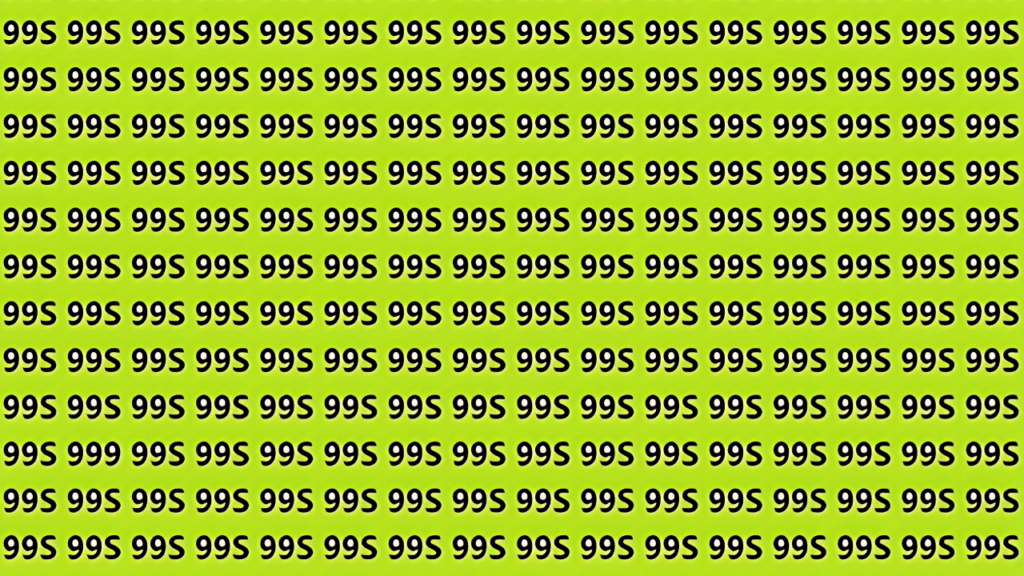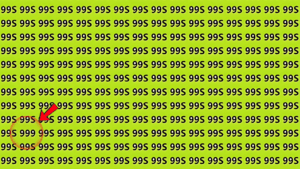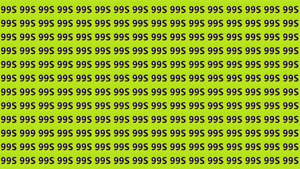
Optical illusions have fascinated humanity for centuries, challenging our perception, teasing our brains, and sparking debates about intelligence and cognitive ability. Among the myriad of visual puzzles circulating online, one particular illusion has captured widespread attention: the challenge to spot the number ‘999’ hidden within a complex image in just five seconds. Dubbed a test for “true geniuses with a higher IQ,” this optical illusion has become a viral sensation, prompting people worldwide to test their mental acuity. In this article, we’ll explore the science behind optical illusions, dissect the ‘999’ challenge, and offer insights into why some people can spot the hidden number faster than others. Whether you’re a puzzle enthusiast or simply curious, read on to uncover the secrets of this brain-bending phenomenon.
What Are Optical Illusions?
Optical illusions are visual images that deceive the brain, causing us to perceive something that differs from reality. These illusions exploit the way our visual system processes information, often creating confusion between what our eyes see and what our brain interprets. They can involve distortions of size, shape, color, or perspective, or they may hide objects within patterns that are difficult to discern.
The ‘999’ optical illusion falls into the category of hidden object illusions, where a specific element—in this case, the number ‘999’—is camouflaged within a busy or intricate design. These types of illusions test not only visual perception but also cognitive skills like pattern recognition, attention to detail, and processing speed. The claim that only those with a “higher IQ” can solve it in five seconds adds an extra layer of intrigue, as it ties the challenge to intelligence, a concept that has long fascinated psychologists and neuroscientists.
The ‘999’ Challenge: What Makes It So Difficult?
At first glance, the ‘999’ optical illusion appears to be a chaotic mix of numbers, shapes, or patterns. The image is designed to overwhelm the viewer, with distracting elements that draw attention away from the hidden number. The challenge is to locate the ‘999’ within a strict time limit of five seconds, which adds pressure and tests the brain’s ability to filter out irrelevant information quickly.
Several factors contribute to the difficulty of this illusion:
- Visual Overload: The image likely contains a multitude of numbers or symbols that resemble ‘999,’ such as ‘666,’ ‘888,’ or ‘777.’ This creates a visual overload, forcing the brain to sift through similar-looking elements to find the correct one.
- Camouflage Techniques: The ‘999’ may be disguised using color, shading, or alignment tricks. For example, it could be embedded within a larger pattern, rotated at an unusual angle, or partially obscured by overlapping shapes.
- Time Pressure: The five-second time limit heightens the challenge by limiting the brain’s ability to methodically scan the image. This tests rapid decision-making and instinctive pattern recognition, skills often associated with high cognitive ability.
- Perceptual Bias: Our brains are wired to focus on familiar patterns or prominent features in an image. If the ‘999’ is hidden in an unconventional way, it may go unnoticed because it doesn’t align with our expectations.
The Science of Spotting Hidden Objects
To understand why some people excel at the ‘999’ challenge, we need to delve into the cognitive processes involved. Spotting a hidden object in an optical illusion requires a combination of visual acuity, attention, and mental flexibility. Here’s how these factors play a role:
- Visual Acuity: Sharp eyesight helps in identifying fine details, but optical illusions often rely on more than just physical vision. The brain’s ability to interpret visual data is equally important.
- Selective Attention: The brain must filter out distractions and focus on relevant parts of the image. People with strong selective attention can ignore the “noise” (e.g., similar numbers or patterns) and zero in on the ‘999.’
- Pattern Recognition: The human brain is adept at recognizing patterns, a skill honed through evolution for survival. In the ‘999’ illusion, those who can quickly identify numerical patterns are more likely to succeed.
- Processing Speed: The five-second time constraint means that faster cognitive processing gives an advantage. This is where the link to IQ comes into play, as higher IQ scores are often associated with quicker information processing.
- Experience with Illusions: People familiar with optical illusions may have an edge, as they’ve trained their brains to look for hidden elements in unconventional ways.
Does IQ Really Matter?
The claim that only a “true genius with a higher IQ” can spot the ‘999’ in five seconds is a bold one. While IQ (Intelligence Quotient) is a measure of cognitive abilities like problem-solving, reasoning, and pattern recognition, its role in solving optical illusions is nuanced. Studies suggest that individuals with higher IQs may process visual information faster and exhibit better attention control, which could help in this challenge. However, other factors, such as experience, practice, and even luck, can also influence performance.
IQ tests typically assess skills like verbal reasoning, spatial awareness, and logical thinking, but they don’t directly measure the ability to solve optical illusions. That said, the ‘999’ challenge does tap into cognitive skills that overlap with IQ, such as:
- Spatial Reasoning: The ability to mentally manipulate and locate objects in a complex visual field.
- Working Memory: Holding and processing visual information under time pressure.
- Problem-Solving: Quickly devising a strategy to scan the image effectively.
While a high IQ might give an edge, it’s not the sole determinant of success. People with average IQs can excel at optical illusions through practice or by adopting effective strategies, such as scanning the image systematically or focusing on areas with high contrast.
Strategies to Spot the ‘999’
If you’re struggling to find the ‘999’ in five seconds, don’t worry—there are techniques you can use to improve your chances:
- Scan Methodically: Instead of letting your eyes wander randomly, scan the image in a grid-like pattern, moving from left to right or top to bottom. This ensures you cover all areas systematically.
- Look for Contrast: The ‘999’ may stand out due to differences in color, brightness, or texture. Focus on areas where numbers appear slightly different from their surroundings.
- Defocus Your Eyes: Sometimes, relaxing your gaze or slightly defocusing your eyes can help the hidden number pop out, as it reduces the brain’s tendency to fixate on distracting details.
- Practice with Similar Illusions: Familiarizing yourself with hidden object puzzles can train your brain to spot patterns more quickly.
- Stay Calm: Time pressure can induce panic, which impairs cognitive performance. Take a deep breath and approach the challenge with confidence.
The Psychology of Viral Challenges
The ‘999’ optical illusion isn’t just a test of perception—it’s also a cultural phenomenon. Viral challenges like this one spread rapidly on platforms like X, where users share their successes, failures, and theories. The appeal lies in the combination of competition, curiosity, and the promise of self-discovery. By framing the challenge as a test of genius, it taps into our desire to validate our intelligence and stand out from the crowd.
Psychologically, these challenges engage our reward systems. Spotting the ‘999’ triggers a dopamine release, giving a sense of accomplishment. The time limit adds an adrenaline rush, making the experience more thrilling. Social media amplifies this by allowing users to compare their performance with others, fostering a sense of community and rivalry.

Are You a Genius?
So, can you spot the ‘999’ in five seconds? Whether you succeed or not, the challenge is a fun way to exercise your brain and explore the quirks of human perception. While a high IQ might help, it’s not the whole story—practice, strategy, and a keen eye can make anyone a master of optical illusions.
If you haven’t tried the ‘999’ challenge yet, search for it online or on X, where users are sharing versions of the illusion along with tips and reactions. Give yourself five seconds, trust your instincts, and see if you can claim the title of “true genius.” And if you don’t spot it right away, don’t be discouraged—optical illusions are designed to trick even the sharpest minds.
Looking Forward
The ‘999’ optical illusion is more than just a viral puzzle; it’s a window into the fascinating interplay of vision, cognition, and psychology. By challenging us to find a hidden number in a sea of distractions, it tests our ability to think quickly, focus intently, and see beyond the obvious. While the link to IQ adds intrigue, the real value lies in the mental workout and the joy of discovery. So, grab a timer, dive into the illusion, and see if you can unravel its secrets in just five seconds. Are you ready to prove your genius?

